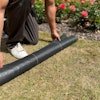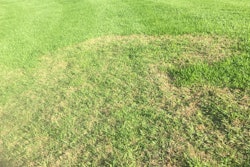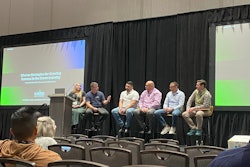
The grass has greened, and lawn care operators are rising to the occasion—but so have those pesky turfgrass weeds and diseases.
Here’s a roundup of the top turfgrass weeds and diseases lawn care operators may expect to see popping up in their customers’ properties.
Weeds
 CrabgrassSyngenta
CrabgrassSyngenta
Large crabgrass
Large crabgrass (Digitaria sanguinalis) is a summer annual weed that germinates when soil temperatures reach 55 degrees F in the spring. It is a grassy weed that grows prostrate along the ground via stolons, or creeping stems. It can be identified due to its large hairs that protrude 90 degrees to either the leaf or stem surface. Large crabgrass will have larger and smoother leaf blades compared to most turfgrass.
 Cloverstock.adobe.com - two K
Cloverstock.adobe.com - two K
Clover
Clover is a group of weeds that are found in many lawns and is characterized by a trifoliate leaf with three leaflets. These are generally perennial plants that regrow from underground structures. The region and specific clover species determine the season that the weed is most prominent. White clover (Trifolium repens) is characterized egg-shaped leaflets with a grayish watermark at the base. Black medic (Medicago lupulina L.) is characterized by egg-shaped leaflets that have an extended petiole (a stalk that attaches a leaf to a stem) on the middle leaflet. Burclover (Medicago polymorpha L.) is similar to black medic but is toothed/serrated on the leaf margins and has hooked tips on the flower.
 NutsedgeSyngenta
NutsedgeSyngenta
Nutsedge
Nutsedge is another group of weeds that are commonly found in lawns and can be easily misidentified as a grasslike weed. They are characterized by having triangular stems with prominent edges. The most common sedges are yellow nutsedge, purple nutsedge and green kyllinga. These are perennial weeds that can regrow from underground structures such as rhizomes or tubers. Yellow nutsedge (Cyperus esculentus) can be identified by the yellowish seed head that it produces. Purple nutsedge (Cyperus rotundus) has a purple to maroon seed head with tiny hairs. Green kyllinga (Kyllinga brevifolia) is smaller than the other two and grows in dense mats with a terminal globelike seed head and three long triangular leaves.
 Poa annuastock.adobe.com - Marina Demidiuk
Poa annuastock.adobe.com - Marina Demidiuk
Poa annua and Poa trivialis
Poa species weeds produce a lot of seed, and they tend to be very diverse biologically. Because of this, seeds can germinate at many different times of the year, and, depending on the climate, many can survive summers and winters and behave like perennial plants. These grasses are lighter in color than Kentucky bluegrass and perennial ryegrass. Poa annua can be seen in May and June due to its prolific seed head production. On the other hand, Poa trivialis rarely produces a seed head when mowed.
Diseases
Dollar spot
 Dollar spotstock.adobe.com - Kathy images
Dollar spotstock.adobe.com - Kathy images
Dollar spot, caused by the fungus Clarireedia jacksonii, manifests as small, circular patches that resemble light tan or bleached silver dollars that may grow upward of 6 inches in diameter. If left unmanaged, these patches can merge to form larger areas of damage, leading to thin and weak turf.
 Brown patchSyngenta
Brown patchSyngenta
Brown patch
Brown patch, caused by the fungus Rhizoctonia solani, is characterized by circular patches of brown or tan dead grass surrounded by a dark ring of active infection, ranging from 6 inches to several feet in diameter. It thrives in warm, humid conditions and can quickly spread in susceptible turfgrass species. Brown patch is most severe when nighttime temperatures are consistently above 70 degrees F.
 Gray leaf spotSyngenta
Gray leaf spotSyngenta
Gray leaf spot
Gray leaf spot, caused by the fungus Pyricularia grisea, typically affects newly established stands of grasses like tall fescue and perennial ryegrass. It presents as small, tan lesions with dark brown borders and gray centers on leaf blades. During times of high moisture or humidity, the lesions will appear gray and fuzzy from fungal sporulation.
 RustSyngenta
RustSyngenta
Rust
Turfgrass rust is a fungal disease that makes the grass seem yellow or orange when viewed from far away. It produces powdery orange spores that can be transferred from leaf blades to shoes, pant legs or mowers. Rust is a disease of slow-growing turf, and newly seeded stands can be susceptible to rust infection.
 Fairy ringRick Latin, Ph.D.
Fairy ringRick Latin, Ph.D.
Fairy ring
Fairy ring is a circular area of abnormal turf growth, common in lawns where there are high levels of organic matter in the soil and where trees were recently removed. This disease does not attack turf directly, but rather, it breaks down organic matter in the soil, such as old roots or a stump. As the organic matter breaks down, nitrogen is released, resulting in dark green arcs or rings of thick, fast-growing grass. In some instances, the circles appear as brown or dead grass.
Sources: Nathan Nordstedt, Ph.D., technical services manager, FMC Corp.; Andrew Osburn, Ph.D., technical services manager, FMC Corp.; Matt Giese, technical services Manager, Syngenta; Aaron Hathaway, technical services manager, Nufarm Americas
Find out how to prevent and eradicate top lawn diseases here.
Find out how to prevent and eliminate turfgrass weeds here.




















